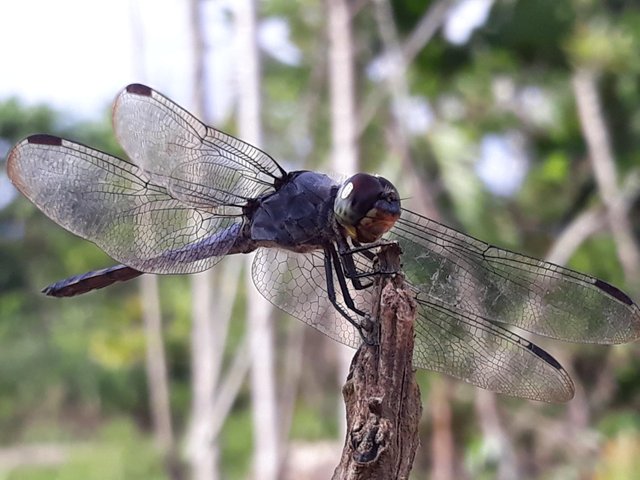
Dragonfly may be a beautiful and attractive looking creature, but make no mistake, they are actually vicious predators with sharp jaws, almost 360-degree vision, and can fly backwards.
Dragonflies are one of the insects that inhabit the planet. They have been through various stages of evolution to be able to perfect the ability to fly and be beautiful and amazing creatures. Here are seven facts about dragonflies that might change your outlook on these unique, ancient, and highly varied insects.
Dragonflies can intercept the prey in the air
Dragonflies would be a creepy monster if we were small insects. Instead of chasing the prey, they intercept it while flying with careful calculations. Dragonflies can accurately assess the speed and trajectory of prey so it can ambush it quickly and effectively. They are very good at this, so the level of success when hunting reaches 95 percent.
Have a very sharp jaw
In addition to an effective hunting strategy, the ability of dragonfly in tearing its prey is also very impressive. When the prey is caught, the dragonfly will hold it with their legs, tearing its wings so that prey can not escape and decapitate them with their sharp jaws. All of that is done dragonfly in the air, without landing at all.
Fortunately, dragonflies can not bite humans, because their jaws are not strong enough to injure our skin. There are only a few species that can bite us, but the dragonfly simply does it as a self defense strategy.
The flying master
Dragonflies can fly in all directions, including sideways and backwards, even flying quietly at one point for more than a few minutes. (Thinkstock)
Only a few animals match the ability of the spearacular dragonflies. Dragonflies have two pairs of wings with muscles between head and abdomen that can move in different directions. This structure allows them to change their individual wing angles and display exceptional flying dexterity.
Dragonflies can fly in all directions, including sideways and backwards, even flying quietly at one point for more than a few minutes. This amazing ability is the secret of their success in ambush prey.
In addition, dragonflies also fly quickly and are superior in terms of durability. Species of the Pantala flavescens dragonfly, even flew across the ocean during migration, traveled up to 11,000 miles and broke records as the world's farthest insect migration.
With its speed, distance, endurance and flexibility, the dragonfly became one of the most extraordinary aviators on Planet Earth.
Exceptional vision
Dragonflies have a compound eye that contains 30,000 facets, each providing information about the environment around the dragonflies. (Thinkstock)
Dragonfly eyes dominate almost all of their heads. Dragonflies have a compound eye that contains 30,000 facets, each providing information about the environment around the dragonflies. His point of view is almost 360 degrees, allowing them to see small insects and ambush them while avoiding collisions with other insects.
Not only that, dragonflies can also see the world in colors we can not imagine. We see the red and blue red combination of colors thanks to the presence of three different types of light-sensitive proteins in our eyes called opsins. While the dragonfly, has no less than 11 different opsin, and some species have 30 opsin.
Can live up to 2 years in the water
Dragonflies lay their eggs in water and when larvae appear, they live in water for more than 2 years. Even in certain areas, some types of dragonflies remain in larval form for up to six years. They change their skin to 17 times until they are ready to get out of the water and transform into a dragonfly we often see in the air.
The dragonfly larvae also have the dexterity of catching prey in the water. Their food is very varied, fellow dragonfly larvae, other insect larvae, tadpoles, even fish. Truly a true predator!
Some species of dragonfly lay their eggs in saltwater
There are only a few insects that live in the ocean. Possible explanation is, because the sea water is very salty and most insects may not be able to tolerate it. But that's not a problem for dragonflies. Some species, such as Erythrodiplax berenicei, can produce offspring in water that are many times saltier than the oceans.
There is a nature reserve for dragonflies
Dragonflies need protection from a variety of destructive human behavior, such as pollution and loss of their natural habitat.
The Dragonfly Center, the first dragonfly sanctuary was built in England in 2009 ago. Located in the Cambridgeshire Nature Reserve, the sanctuary is expected to stop the decline in a population of 42 species of dragonflies commonly found in Britain.
In America, dragon lovers can visit the Dragonfly Sanctuary Pond in Albuquerque, New Mexico to meet directly with a variety of species of dragonfly.
In Asia, you can play with dragonflies of various types, one of them in Dragonfly Nature Park, Shimanto City, Shikoku, Japan. The Japanese government built a bonfire to protect the insect's habitat and its species diversity.
Dragonflies are meritorious to humans because they help us control the population of insects, such as mosquitoes and other biting insects. They also inspire us to create cutting-edge technology based on their outstanding ability to fly and see. At least, we can repay the favor by supporting the conservation of the dragonfly habitat, so we can see the beauty of this remarkable insect much longer.
Source :www.mnn.com
 )
)
Well done
Downvoting a post can decrease pending rewards and make it less visible. Common reasons:
Submit
The information on the dragonfly is very interesting and the spectacular photo .
Downvoting a post can decrease pending rewards and make it less visible. Common reasons:
Submit